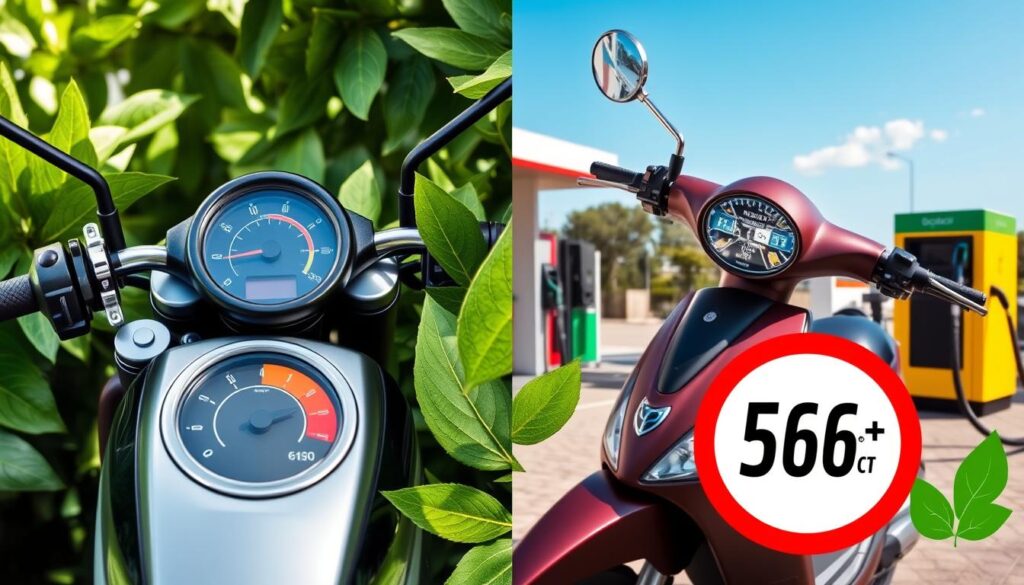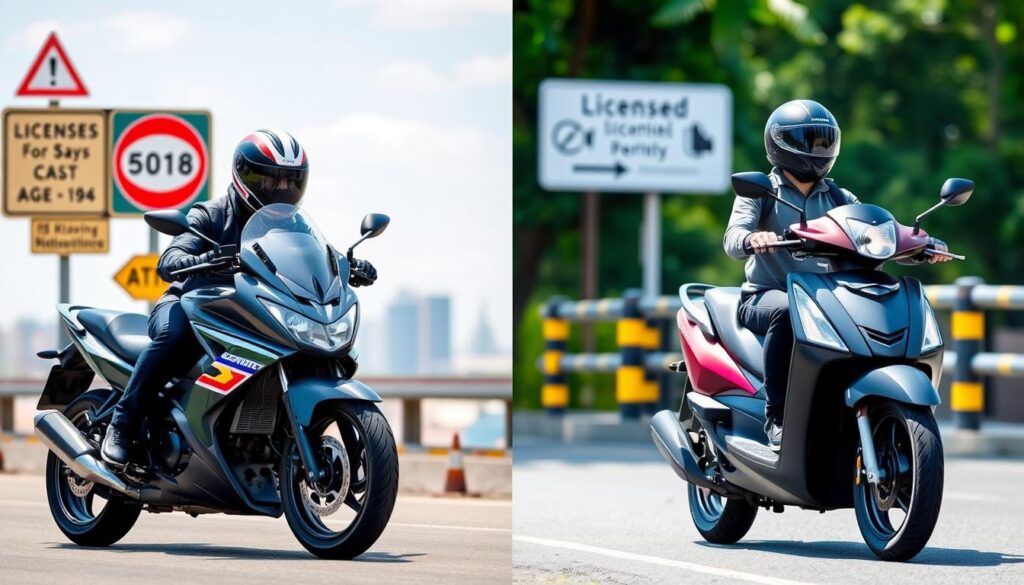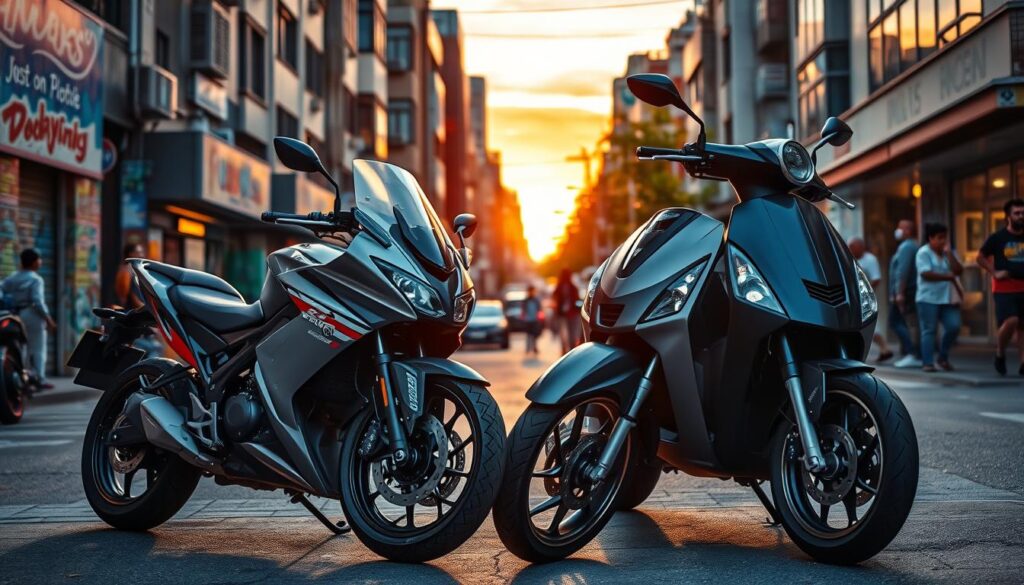Standing at the crossroads of urban transportation, your heart beats with excitement. Choosing between a motorcycle or a scooter can change your daily commute and lifestyle. This journey is yours to explore, whether you’re a seasoned rider or new to two-wheeled vehicles.
The open road calls to you, but city living has its own needs. Which ride will meet your needs, desires, and sense of freedom? Let’s explore motorcycles and scooters to find your perfect match.
In This Guide
Understanding Two-Wheeled Vehicle Basics
When comparing motorcycles and scooters, it’s key to know the basics. This includes engine displacement and braking systems. Knowing these can help you choose the right ride for you.
Key Components and Terminology
Motorcycles and scooters have similar parts like wheels and handlebars. But, how these parts are designed and placed can differ a lot.
Common Features of Both Vehicles
- Wheels: Both motorcycles and scooters usually have two wheels, but some have three.
- Handlebars: These let the rider steer and control the vehicle.
- Engine: The engine powers both motorcycles and scooters to move forward.
Basic Operating Principles
Starting, speeding up, and stopping are key for motorcycles and scooters. But, the way these actions happen can vary. This depends on engine displacement and how the transmission is set up.
“Understanding the basic components and operating principles of motorcycles and scooters is the first step in determining which type of two-wheeled vehicle best fits your needs and preferences.”
Motorcycle vs Scooter: Main Differences Explained
Motorcycles and scooters are two different types of two-wheeled vehicles. They offer unique experiences based on their design and use. Knowing the main differences helps you choose the right one for you.
Engine size and power are big differences. Motorcycles have bigger engines, from 250cc to over 1,000cc. This means they go faster and accelerate quicker. Scooters have smaller engines, from 50cc to 250cc. They use less fuel but don’t go as fast.
The way the vehicles are built also differs. Motorcycles have a traditional frame and big wheels. This makes them stable and easy to handle. Scooters have a step-through frame and small wheels. They’re great for city riding but not as stable at high speeds.
Transmission types also vary. Motorcycles usually have manual transmissions. This lets riders control the power better. Scooters have automatic or CVT transmissions. They’re easier to use, especially in heavy traffic.
| Feature | Motorcycle | Scooter |
|---|---|---|
| Engine Size | 250cc to 1,000cc+ | 50cc to 250cc |
| Wheel Size | 16 inches or more | 12 inches or less |
| Transmission | Manual, multi-gear | Automatic or CVT |
These key differences affect how motorcycles and scooters perform and feel. Understanding these can help you pick the best two-wheeled vehicle for you.
Engine Power and Performance Comparison
When picking between a motorcycle and a scooter, engine power matters a lot. We’ll look at engine size, top speed, and how power is delivered in these vehicles.
Engine Displacement Ranges
Motorcycles have bigger engines, from 250cc to 1,000cc or more. This means they can go faster and have more power. Scooters, with engines from 50cc to 300cc, focus on saving fuel and being easy to handle in the city.
Top Speed Capabilities
Motorcycles can go really fast, over 100 mph, thanks to their big engines and design. Scooters, made for city rides, usually top out at 40 mph to 80 mph. This depends on the engine size and scooter model.
Power Delivery Systems
Motorcycles have manual transmissions, giving riders control over power. Scooters use automatic CVTs for smooth power delivery. This is great for city driving and stopping often.
Knowing how motorcycles and scooters perform can help you choose the right one. It depends on what you need and like in a ride.
Design and Ergonomics
When choosing between a motorcycle and a scooter, design and ergonomics are key. These factors affect your comfort, handling, and riding experience. From the frame to the seating position, each detail matters.
Seating Position and Control Layout
Motorcycles have an upright seating position. This lets riders see the road better and feel stable. They’re great for long rides and highway trips.
Scooters, however, have a more laid-back seating position. This is better for city transportation and quick turns in urban areas.
Motorcycles need more rider input due to their controls. They have a clutch, gear shifter, and footpegs. Scooters, with their twist-and-go throttle and auto transmission, are easier to use. They’re perfect for new riders or those who want a calm ride.
Frame Design and Stability
Motorcycles have larger wheels and a longer wheelbase. This makes them stable and controlled at high speeds. They’re great for long trips and high-performance riding.
Scooters, with their smaller wheels and compact frames, are better for city riding. They’re easy to maneuver in tight spaces and heavy traffic.
| Characteristic | Motorcycle | Scooter |
|---|---|---|
| Seating Position | Upright, legs extended forward | Relaxed, feet-forward |
| Control Layout | Clutch, gear shifter, footpegs | Twist-and-go throttle, automatic transmission |
| Frame Design | Larger wheels, longer wheelbase | Smaller wheels, more compact frame |
| Stability | Greater stability at high speeds | More maneuverable in urban settings |
When choosing between a motorcycle and a scooter, think about your needs and preferences. Consider your riding style and where you’ll use the vehicle. Knowing the differences helps you choose the right one for a comfortable and enjoyable ride.
Riding Position and Comfort Features
Choosing between a motorcycle and a scooter depends a lot on the riding position and comfort. The way you sit can greatly affect your ride, especially on long trips and in the city.
Impact on Long-Distance Travel
Motorcycles have a more upright riding position, which is good for long rides. This helps spread your weight evenly, making you less tired and uncomfortable. Scooters, with their relaxed seating, are better for short trips but can get tiring on long ones.
Urban Maneuverability Aspects
Scooters are great for city driving because they’re small and easy to turn. They fit well in tight spaces and can cut through traffic easily. Motorcycles are faster and more agile, but they’re bigger and harder to maneuver in tight spots.
Passenger Accommodation
- Motorcycles have more room for passengers, with a special seat and footrests.
- Scooters have less space for passengers, making long rides less comfortable.
- Carrying a passenger on a scooter can make it harder to control, affecting how it handles.
Choosing between a motorcycle and a scooter depends on what you need and like. Think about the seating, comfort, and space for passengers. This will help you decide what’s best for city driving and long trips.
| Feature | Motorcycle | Scooter |
|---|---|---|
| Riding Position | Upright and forward-leaning | Relaxed, feet-forward |
| Long-Distance Comfort | Better weight distribution, less fatigue | May become tiring on extended journeys |
| Urban Maneuverability | Larger size, less agility in tight spaces | Compact size, tighter turning radius |
| Passenger Accommodation | Spacious pillion seat and footpegs | Smaller passenger area, potentially less comfortable |
Cost Considerations: Purchase and Maintenance
When looking at motorcycles and scooters, the cost is key. Motorcycles usually cost more upfront, with many models and brands available. Scooters, however, are often cheaper, making them great for city rides.
Maintenance costs differ a lot, based on the model, engine size, and how handy you are. Motorcycles need more frequent checks, like oil changes and tire swaps. Scooters, though, are easier to keep up, saving you money over time.
Scooters also win in fuel efficiency, using less gas than motorcycles. This means you can save a lot on fuel, especially if you drive a lot in the city.
| Feature | Motorcycles | Scooters |
|---|---|---|
| Purchase Cost | Higher | Lower |
| Maintenance Costs | Higher | Lower |
| Fuel Efficiency | Moderate | Higher |
Choosing between motorcycles and scooters depends on your needs, budget, and what you like. Do your homework and compare different models. This will help you pick the best fit for your life and wallet.

Fuel Efficiency and Environmental Impact
Choosing the right vehicle for city travel is key. Motorcycles and scooters are seen as green options. But how do they really compare in fuel use and carbon output?
Average MPG Comparisons
Motorcycles are known for their fuel efficiency, often getting 50 to 70 MPG. Scooters can do even better, reaching 80 to 100 MPG. This makes them great for saving fuel and reducing environmental impact in the city.
Environmental Regulations
Recently, stricter rules have been set to cut emissions from all vehicles, including bikes and scooters. These rules have led to cleaner, more efficient engines. This makes two-wheeled city travel more eco-friendly.
Carbon Footprint Analysis
Motorcycles and scooters have a big edge over bigger cars in carbon output. They use less fuel and are lighter, which lowers their carbon footprint. In fact, studies show their emissions are 75% less than cars, making them a greener choice for city travel.
| Vehicle Type | Average MPG | Carbon Emissions (g CO2/mile) |
|---|---|---|
| Motorcycle | 60 MPG | 80 g CO2/mile |
| Scooter | 90 MPG | 60 g CO2/mile |
| Passenger Car | 25 MPG | 320 g CO2/mile |
The data clearly shows motorcycles and scooters are better for the environment and fuel. They’re a smart choice for those wanting to lower their carbon footprint and help make city travel greener.
License Requirements and Legal Considerations
Operating two-wheeled vehicles in the U.S. has different rules for motorcycles and scooters. Knowing these rules is key to following the law and staying safe.
License Requirements Explained
The rules for driving a motorcycle or scooter depend on the vehicle’s classification. Motorcycles usually need a special license or endorsement. Scooters might be okay with a standard driver’s license, depending on engine size and speed.
To ride a motorcycle, you often need a motorcycle-specific license. This means passing a safety test and a riding skills test. The exact rules vary by state, so check with your DMV.
Scooters have more relaxed rules. Many states let you use a standard driver’s license for scooters with small engines and slow speeds. But, always check your state’s laws for any extra rules.
Other Legal Considerations
There are more laws to follow when riding a motorcycle or scooter. This includes:
- Helmet laws: Many places require helmets for both motorcycle and scooter riders. There are rules for what kind of helmet is okay.
- Lane splitting: Some places allow motorcycles to ride between lanes of slow traffic. Others don’t.
- Registration and insurance: Both motorcycles and scooters need to be registered and insured, just like cars.

Storage Capacity and Practicality
When you’re using urban transportation, how much you can carry matters a lot. Both motorcycles and scooters have their own strengths in storage. They fit different riding styles and needs.
Built-in Storage Solutions
Motorcycles are known for their big storage spaces. Many models have large compartments, saddlebags, or trunks. This lets you carry your daily stuff, like work items or groceries, making your trips more efficient.
Scooters, however, have under-seat storage. It’s a handy spot for your helmet or small things.
Aftermarket Storage Options
If your bike or scooter’s built-in storage isn’t enough, there are many aftermarket options. You can get top cases, sidebags for motorcycles, or storage racks and cargo boxes for scooters. This way, you can make your ride fit your needs, whether for daily trips or weekend getaways.
Daily Utility Comparison
The storage and practicality of your vehicle affect your daily life. Motorcycles are great for carrying big or bulky items. They’re versatile for those who need to transport large cargo.
Scooters, though, are better for city life. They’re easy to maneuver and have compact storage. This is perfect for navigating tight city streets or finding parking spots.

